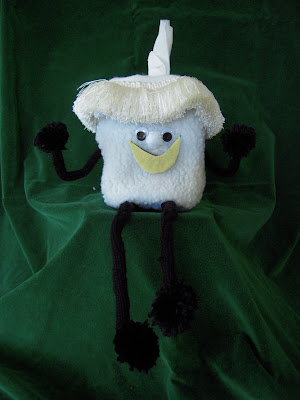Tissue box mood control – try tackling it Tuesday
As with most tips and tricks around here, this has been scientifically, nay, exhaustingly tested for your benefit. I can assure you that it is 100% effective for one typical and one atypical child. Conversely, it is completely ineffective for another typical and atypical child. Thusly, an overall 50% success rate is worth a bash in my book.
Follow the basic principles in “tissue box.” Choose the fabric with care to cause minimum offense, remain gender neutral and avoid tickly, scratchy, itchy textures. Fleeces usually fit the bill, are cheap and easy to work with since they don’t fray.
White is usually a poor choice when filthy snotty children are involved but the sheep-like woolly texture was a definite favourite.
Select a decorative trim that could resemble hair and stitch to the inside top seam so that when it falls open, the fringe appears on the outside.
Tie the ‘neck’ with chord or some easily un-doable yarn.
Sew googley eyes in place with a pompom for the nose.
Knit four tubes in stocking stitch and insert pipe-cleaners inside. Take care to fold over the top sharp edges so that it doesn’t poke through the knitting and hurt small fingers. Stitch one pompom to one end of each of the four tubes. Stitch the other end to the tissue box cover to form legs and arms, which should now be ‘poseable.’
Take a small piece of recycled stiff plastic and cut into a moon shape for the mouth. Glue fractionally larger pieces of felt to each side of the plastic form, black on one side and a contrasting colour on the other. Leave to dry.
Once fully dry roughen up a little patch in the centre of each side. Attach hook Velcro to the tissue box cover in the ‘mouth’ position. Make sure that there is enough space so that the ‘mouth’ can fit upside down and right way up to form a ‘happy’ or ‘sad’ face. Try to avoid putting Velcro on the mouth itself as this may mean it is untouchable for some children.
Broadly speaking this is only effective for the sniffly kind of hurt feelings or ruffled feathers. It is certainly ineffective where genuine pain and the Emergency Room is required.
Usage guidance:-
Await an attack of the sniffles. This usually doesn’t take very long. Ensure that the tissue box is in the ‘sad’ position, mouth and limbs turned downward. Take box to child. Cuddle sniffly child with box close to hand and within sight line of the child.
Listen carefully to the complainant's woes. Offer solicitation, comfort and solace as needed. When sniffling is on the decline, suggest use of a tissue to mop up streaky cheeks and slimed nostrils. Encourage child to pull a tissue from the box. Encourage child to spread mucus over face with tissue. On completion remove offensive, germ filled tissue before it hits the floor.
Encourage child to verbally acknowledge that the storm has passed and that they have survived in tact. Positively reinforce recognition of wellness by encouraging the child to physically turn the mouth into a smile and the limbs into a horray! The kinesthetic or physical interaction, by moving the pieces, confirms success. This helps the child associate self care and self calming, motivates and promotes self awareness. This is why we bother to put a line through a completed ‘to do’ item. Even though strictly speaking it is unnecessary, the task is finished, but somehow, great satisfaction derives from this teeny tiny step.
Of course if your child has tactile defensive issues such that they find the texture of paper or tissues abhorrent, then forget it.








No comments:
Post a Comment